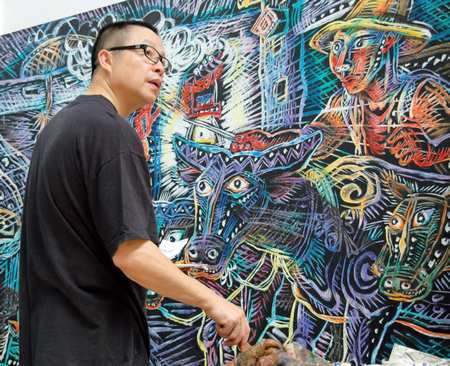more>>More News
- National Day
- ways to integrate into Chinese style life
- Should they be in the same university with me?!!
- Chinese Ping Pang Legend: the Sun Will Never Set
- A Glance of those Funny University Associations
- mahjong----The game of a brand new sexy
- Magpie Festival
- Park Shares Zongzi for Dragon Boat Festival
- Yue Fei —— Great Hero
- Mei Lanfang——Master of Peking Opera
Artworks' new home
By admin on 2015-01-16

Luo Zhongli in from of
his work.
By Wu Ziru
The Contemporary Art Academy of China sparked nationwide debate when it was founded in November. The State-owned academy recently announced plans for a new contemporary art museum and a systematic research project as its first exhibition gets underway at the National Art Museum of China (NAMOC).
Several critics have voiced their doubts and concerns about the exhibition in terms of whether the academy can satisfy with their roughly-organized event and whether the few works on display are in keeping with the ambitious title, Constructed Dimension, said to "comb the inner construction of Chinese contemporary art," by artistic director Ye Yongqing.
Criticism regarding the foundation of the academy has subsided somewhat with many now holding high expectations, especially after the director, renowned contemporary artist and art educator Luo Zhongli, announced new plans at a seminar that accompanied the exhibition.
According to Luo, the academy's most important tasks will be organizing the writing of a comprehensive series of books on the development of Chinese contemporary art over the past few decades, from its beginnings to today's successes. It also plans to build China's first national contemporary art museum to showcase Chinese contemporary art to the world.
In the eyes of Luo, Chinese contemporary art is at a truly international level after decades of hard work by numerous artists with free spirits and has proven itself commercially, in a way that stunned many in and outside of China.
"Today it's time to look back on the long journey, to give systematic, thorough research on these artists and the times," Luo told the Global Times.
A significant amount of work is already underway in this regard in China's art circle - several exhibitions themed to present Chinese contemporary art's history have been organized and various books, including catalogues of large-scale exhibitions and compositions by independent critics and curators exploring the art genre, are available at art book stores.
However, most works on the subject are regarded as not serious enough or even too impartial, as several were driven by commercial considerations and many critics regard works by independent individuals as not thorough enough, as documenting the entire genre is a complicated and difficult historic task.
The massive-scale exhibition Reshaping History held in May, including more than 300 contemporary artists, was aimed at being "the most sufficient display of the achievements during the past 30 years of development of Chinese contemporary art," according to curator Lü Peng. It was later rumored to be a purely commercial event, as a large percentage of sales went to the organizer.
Disappointed with such exhibitions held by individuals or nongovernmental organizations, many are now holding high hopes for the Contemporary Art Academy of China. Affiliated to the Chinese National Academy of Arts and a State-owned institute, the academy should not have to rely on commercial events to stay afloat.
"It is indeed urgent to explore the history of Chinese contemporary art comprehensively and seriously," art enthusiast Yuan Weiseng told the Global Times after seeing the current exhibition at NAMOC. "We hope the Contemporary Art Academy of China can achieve this, it would be a great benefit to all."
The academy will also work toward building a Chinese contemporary art museum in the near future, director Luo stated, another promise that most are eagerly anticipating.
"There is no permanent, large venue presenting Chinese contemporary art," Luo said. "We need such a place, to present our contemporary art to the world, or we will regret it decades later when someday we find that all valuable and meaningful works will only be seen in museums and galleries overseas."
Despite that fact that several galleries and small-scale museums in China are devoted to displaying Chinese contemporary art, there is none as famous as the Guggenheim and MOMA, where the most important Chinese contemporary pieces are currently collected and occasionally displayed.
Seldom appearing at public events and often not talking to the media, the prospect of a new art museum saw Luo excited and quite talkative on the topic. "Many artists have promised me that they would donate some of their important works to the museum," he told the Global Times.
He said he will try his best to persuade the government to allocate a venue and funding and have the new facility ready as soon as possible.
- Contact Us
-
Tel:
0086-571-88165708
0086-571-88165512E-mail:
admission@cuecc.com
- About Us
- Who We Are What we do Why CUECC How to Apply
- Address
- Study in China TESOL in China
Hangzhou Jiaoyu Science and Technology Co.LTD.
Copyright 2003-2024, All rights reserved




 Chinese
Chinese
 English
English
 Korean
Korean
 Japanese
Japanese
 French
French
 Russian
Russian
 Vietnamese
Vietnamese
